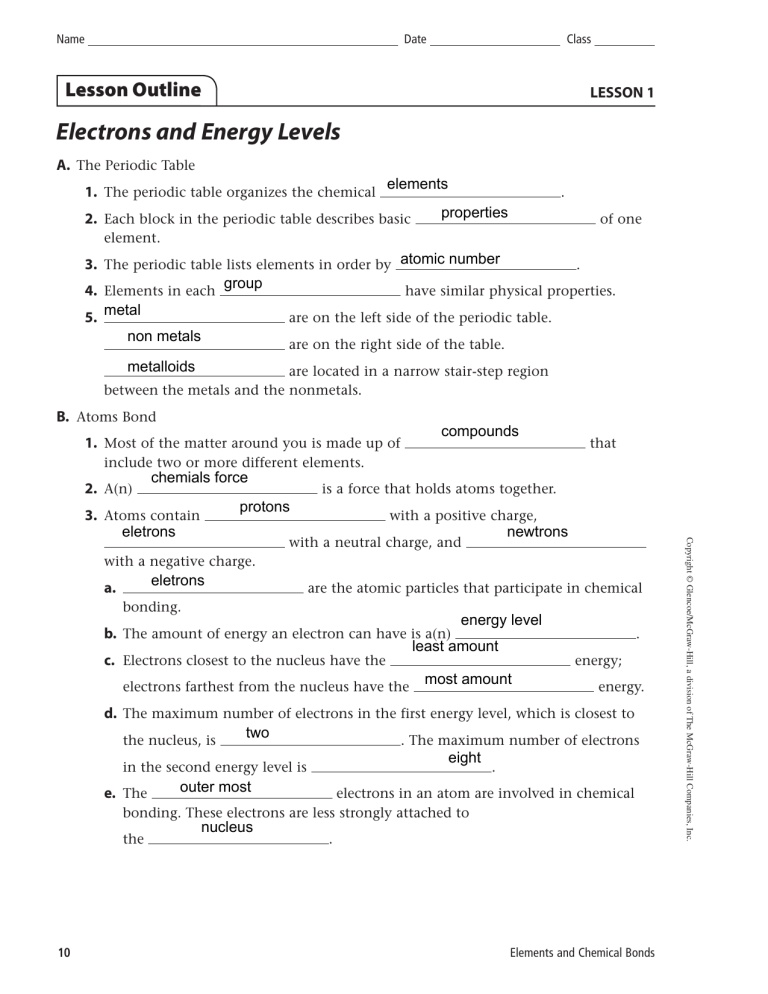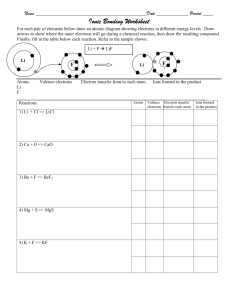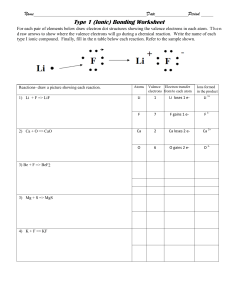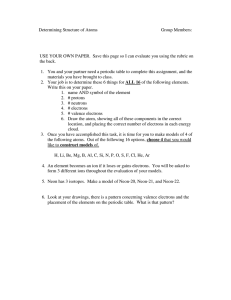
Name Date Class Lesson Outline LESSON 1 Electrons and Energy Levels A. The Periodic Table 1. The periodic table organizes the chemical elements 2. Each block in the periodic table describes basic . properties of one element. 3. The periodic table lists elements in order by atomic number . group 4. Elements in each have similar physical properties. 5. metal non metals are on the left side of the periodic table. are on the right side of the table. metalloids are located in a narrow stair-step region between the metals and the nonmetals. B. Atoms Bond 1. Most of the matter around you is made up of compounds that include two or more different elements. 2. A(n) chemials force is a force that holds atoms together. protons with a positive charge, newtrons with a neutral charge, and with a negative charge. eletrons a. are the atomic particles that participate in chemical bonding. energy level b. The amount of energy an electron can have is a(n) least amount c. Electrons closest to the nucleus have the most amount electrons farthest from the nucleus have the . energy; energy. d. The maximum number of electrons in the first energy level, which is closest to two the nucleus, is . The maximum number of electrons eight in the second energy level is e. The . outer most electrons in an atom are involved in chemical bonding. These electrons are less strongly attached to the 10 nucleus . Elements and Chemical Bonds Copyright © Glencoe/McGraw-Hill, a division of The McGraw-Hill Companies, Inc. 3. Atoms contain eletrons Name Date Class Lesson Outline continued 4. A(n) is an outermost electron that participates in chemical bonding. a. The number of valence electrons in an atom tells you how many an atom can form. b. Each element in the same in the periodic table has the same number of valence electrons. 5. The is a model that represents valence electrons in an atom as dots around the element’s chemical symbol. a. To create an electron dot diagram, draw one dot for each electron in the atom, placing one dot on each of the and then pairing additional dots. b. The number of sides of the symbol dots in the electron dot diagram tells you how many bonds an atom can form. 6. Many atoms are stable with valence electrons. An atom with at least one unpaired electron is a. . atoms do not easily react with or form bonds with Copyright © Glencoe/McGraw-Hill, a division of The McGraw-Hill Companies, Inc. other atoms. b. Group 18 includes the ; with the exception of helium, each of these gases have eight valence electrons and are stable. c. Unstable atoms can become stable only by forming with other atoms. d. Atoms tend to gain, lose, or share valence electrons until each atom has the same number of valence electrons as the e. Stable atoms have Elements and Chemical Bonds . pairs of valence electrons. 11




